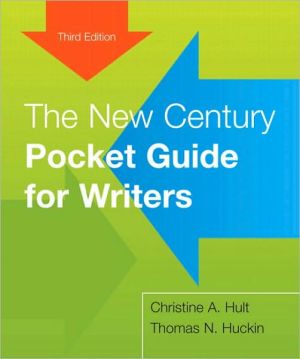The New Century Pocket Guide for Writers
The New Century Pocket Guide for Writers, 3/e offers everything a handbook should in a portable, inexpensive pocket edition. This handbook offers extensive coverage of grammar, usage, and documentation as well as essential coverage of the writing and research process. It includes coverage of writing in the disciplines, evaluating and using sources and avoiding plagiarism, and conducting research projects using the Internet making it the most valuable pocket handbook available.
Search in google:
The perfect quick and inexpensive grammar and writing reference for anyone who wants to write well. The New Century Pocket Guide for Writers, 2e, includes extensive coverage of grammar, usage, and documentation and provides essential coverage of the writing and research processes. Any writing or grammar questions you have can be found in this resource, explained in a easy-to-understand, “just what you need to know” way.
I. WRITING AND RESEARCH. 1. Drafting and Revising. Invent and prewrite.Gather information.Develop and refine your thesis.Review.Draft.Collaborate.Revise.Edit.Proofread.Give and receive feedback.2. The Research Project and Using the Internet. Become a researcher.Schedule a time frame.Create a research notebook.Create a working bibliography.Gather background information.Conduct focused research.Use Internet sources throughout the research process.Get to know the Internet and the Web.Search the Internet and the Web.3. Evaluating and Using Sources: Avoiding Plagiarism. Choose legitimate sources.Use sources responsibly.Avoid plagiarism.Paraphrase sources accurately.Summarize sources briefly.Quote sources sparingly.4. Writing the Research Paper. Review your purpose, audience, and thesis.Plan a structure.Write a draft.Review and revise the draft.Follow formatting conventions.Writing Across the CurriculumDisciplinary research.Disciplinary discourse.Writing about literature.Writing in the natural and social sciences.II. DOCUMENTATION. 6. MLA Documentation. A Directory to the MLA System.Integrate sources and avoid plagiarism in the MLA system.Use the MLA system for in-text citations.Format bibliographic footnotes according to the MLA system.Format the Works Cited page according to the MLA system.Review a sample research paper in MLA format.7. APA, CMS, and CBE Documentation. APA System.A Directory to the APA system.Integrate sources and avoid plagiarism in the APA system.Use the APA system for in-text citations.Format any content notes according to the APA system.Format the References page according to the APA system.Review a sample research report in APA format.CMS System.Integrate sources and avoid plagiarism in the CMS system.Use the CMS system for in-text citations.Format notes according to the CMS system.Format bibliographic entries according to the CMS system.CBE System.Integrate sources and avoid plagiarism in the CBE system.Use the CBE system for in-text citations.Format the References page for the citation sequence in CBE style.III. DESIGN, WEB SITES, AND SPECIAL COMMUNICATIONS. 8. Design in Print and on the Web. Follow the three basic design principles.Use formatting tools.Use graphics.Designing for the Web: Generate a basic design.Methods used to construct Web pages.HTML editors and HTML codes.Refine your Web site.Transfer your site to an Internet server.9. Writing for Different Purposes. Write concise and professional business letters.Write specifically tailored letters of application.Write appropriately packed resumes.Practice good email etiquette.Use file attachments.Use instant messaging.Prepare thoroughly for oral presentations.Pick your visual aids carefully.Practice, practice, practice.Use PowerPoint.IV. COMMON GRAMMAR PROBLEMS. 10. Sentence Structure. Lean to identify parts of speech.Learn to identify basic sentence patterns.Learn to expand and classify sentences.Vary your sentence types.11. Pronouns, Verbs, Adjectives, and Adverbs. 12. Sentence Fragments, Comma Splices and Run-on Sentences. 13. Subject-Verb Agreement. 14. Misplaced and Dangling Modifiers. 15. Faulty Shifts. V. EFFECTIVE SENTENCES AND WORDS. 16. Clarity of Sentence Structure. Clarity and Conciseness.Coordination and Subordination.Parallelism.Variety.17. Word-Processing Tools and Online Resources. Use style/grammar checker only with caution.Use style templates.Use other applications for sentence revisions.Consult Internet resources for writing help.18. Choosing the Right Words and Avoiding Biased Language. Choose words that have the right meaning.Choose words that have the right connotation.Find the right level of formality.Avoid jargon, slang, or dialect.Avoid pretentiousness.Use figurative language.Avoid biased gender references.Avoid biased language about race and ethnicity.Avoid biased language about age and other differences.VI. PUNCTUATION. 19. End Punctuation. 20. The Comma, Semicolon and Colon. 21. The Apostrophe and Quotation Marks. 22. Other Punctuation Marks. VII. MECHANICS AND SPELLING. 23. Capital Letters, Italics, Abbreviations, and Numbers. 24. The Hyphen, Spelling and Using a Thesaurus and Dictionary. VIII. ESL ISSUES. 25. Tips on Nouns, Articles, Verbs, Word Order and Vocabulary. Nouns and Articles.Phrasal Verbs and Verb Complements.Verbs of State.Conditional Sentences.Tips on Word Order.Tips on Vocabulary.Glossary of Usage. Index.








